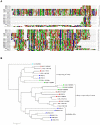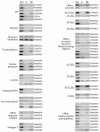An annotated catalogue of salivary gland transcripts in the adult female mosquito, Aedes aegypti
- PMID: 17204158
- PMCID: PMC1790711
- DOI: 10.1186/1471-2164-8-6
An annotated catalogue of salivary gland transcripts in the adult female mosquito, Aedes aegypti
Abstract
Background: Saliva of blood-sucking arthropods contains a cocktail of antihemostatic agents and immunomodulators that help blood feeding. Mosquitoes additionally feed on sugar meals and have specialized regions of their glands containing glycosidases and antimicrobials that might help control bacterial growth in the ingested meals. To expand our knowledge on the salivary cocktail of AEdes aegypti, a vector of dengue and yellow fevers, we analyzed a set of 4,232 expressed sequence tags from cDNA libraries of adult female mosquitoes.
Results: A nonredundant catalogue of 614 transcripts (573 of which are novel) is described, including 136 coding for proteins of a putative secretory nature. Additionally, a two-dimensional gel electrophoresis of salivary gland (SG) homogenates followed by tryptic digestion of selected protein bands and MS/MS analysis revealed the expression of 24 proteins. Analysis of tissue-specific transcription of a subset of these genes revealed at least 31 genes whose expression is specific or enriched in female SG, whereas 24 additional genes were expressed in female SG and in males but not in other female tissues. Most of the 55 proteins coded by these SG transcripts have no known function and represent high-priority candidates for expression and functional analysis as antihemostatic or antimicrobial agents. An unexpected finding is the occurrence of four protein families specific to SG that were probably a product of horizontal transfer from prokaryotic organisms to mosquitoes.
Conclusion: Overall, this paper contributes to the novel identification of 573 new transcripts, or near 3% of the AE. aegypti proteome assuming a 20,000-protein set, and to the best-described sialome of any blood-feeding insect.
Figures









References
-
- Ribeiro JMC. Blood-feeding arthropods: Live syringes or invertebrate pharmacologists? Infect Agents Dis. 1995;4:143–152. - PubMed
-
- Transposable element similar to Strongylocentrotus TE http://www.ncbi.nlm.nih.gov/sutils/blink.cgi?pid=72011940
-
- Tc1-like transposase http://www.ncbi.nlm.nih.gov/sutils/blink.cgi?pid=76154387
Publication types
MeSH terms
Substances
Grants and funding
LinkOut - more resources
Full Text Sources
Other Literature Sources
Molecular Biology Databases

